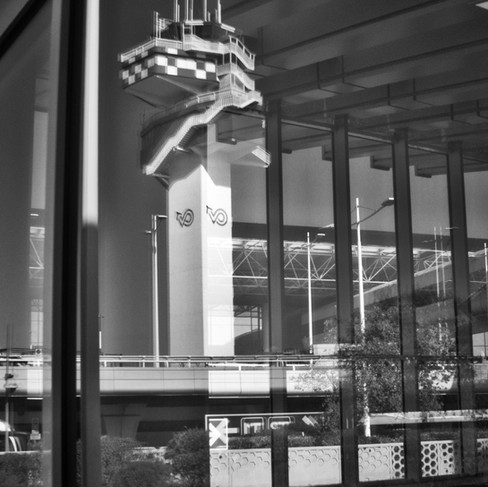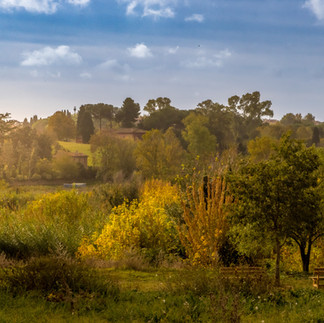Exploring Rome During the Catholic Holy Year
- mcneiljune2
- Oct 30
- 8 min read
October 24th - 28th, 2025
2025 is the Catholic "Holy Year," which occurs once every 25 years and drawing pilgrims from around the world. The motivation to visit at this time was less about institutional decree and more about a personal desire to visit Rome, a long held promise. For me, the trip represented an opportunity to take my camera to a new location and the possibility of new subjects. We were set to go.
On our way
Watching the familiar coastline of Malaga recede we followed our route across mainland Spain, the Balearics and Sardinia before reaching the Italian coastline and quickly thereafter, Rome's principal airport, Fiumicino.
With train tickets purchased online and the promise of a swift journey to arrive close to our centrally located accommodation, we had an hour of waiting time to fill. Rather than just watch time pass passively, I decided to explore potential photography opportunities. Although nothing of architectural merit presented itself, the delay was transformed into an enjoyable, observational warm-up before our metropolitan adventure truly began.
The afternoon sun cast long, dramatic shadows as we checked into our accommodation, providing a welcome window of opportunity for exploration before dusk. Our first instinct, a walk to the iconic Colosseum, beckoned. The sunlight was a potent force, its brightness prompting me to focus on the stark silhouettes of ancient stone and towering arches with statues on top, attempting to capture the grandeur of the scene through the interplay of light and shadow as we navigated the bustling streets.
Deciding to head back to our accommodation after a while because of the number of people out and about, we agreed to investigate the area again after dark. The bustling crowds that filled the historic areas by day, had made it nearly impossible to find a clear vantage point or a moment of compositional stillness. I was hopeful that there might be a thinning of the tourist throngs and the nocturnal atmosphere would grant a solitude offering a far greater chance to compose images that captured the soul of the place without the constant interruption of passing figures.
Although my initial impression of Rome failed to ignite any immediate spark of inspiration, I clung to the hopeful anticipation that the following day would offer more varied and compelling encounters. Our plan was to venture out on the metro to church at an apparently lesser-known location, a journey driven by a desire to fulfill an act of religious piety. For my part, I viewed the expedition as a chance to explore fresh photographic opportunities away from the well-trodden tourist paths, quietly optimistic that the city's hidden layers would finally reveal a more authentic and visually stimulating character.
The immediate surrounds offered little inspiration; the church grounds had been overtaken by an impending musical event. Various pieces of intrusive equipment—scaffolding, cables, and enormous speaker stacks—had taken root, and any chance of quiet contemplation was shattered by the merciless testing of the loudspeakers, which blasted pop music into the air.
A few potential images caught my eye, however it was disappointing.
The main mission had been completed and we swiftly decided to head toward the River Tiber, intent on seeking out some areas I had previously noted as of possible photographic interest.
Getting to the first of the locations I'd identified was like swimming against a strong tide of humanity; an experience that was at once uncomfortable, stressful, and utterly demoralizing. My senses were constantly assaulted, making it impossible to think properly amidst the chaos. Eventually arriving at the building where I wanted to take a photograph, I desperately hoped for respite from the ordeal; however, there was none to be found. Instead, guided tours simply blocked my view, showing no respect at all as I pointed my camera, further deepening my frustration.
We sought a reprieve from the urban intensity by heading towards the river, in the hope that the sight of flowing water would restore a measure of calm. The riverbank delivered, offering a peaceful interlude where we lingered, letting the steady current soothe our frayed nerves.
After a while we were ready to turn our attention towards reaching the imposing silhouette of the Castel Sant'Angelo This fortress had been the focus of my photographic ambition, a site where I envisioned capturing compelling perspectives. Our approach however, revealed a stark reality: the closer we drew, the more evident it became that taking any meaningful photographs—or even simple ones—would be impossible. The area was utterly besieged, people swarming every vantage point like a plague of ants, making movement and even breathing a chore. Defeated, we pivoted sharply away, managing only a hurried, opportunistic shot gazing across toward the Vatican City.
In a desperate bid to escape the throngs of the city's main thoroughfares, we negotiated a labyrinth of back streets, hoping for a quieter passage. However, even these ostensibly calmer streets pulsed with an unexpected energy. A growing cacophony of distant shouts and blaring sirens quickly solidified into an immediate, overwhelming din. A heavy police presence, their vehicles lining the narrow lanes, soon revealed the cause: a massive anti-government protest was unfolding, presenting a formidable challenge for our already weary minds and bodies to overcome. With a quick, almost reflexive stop for sustenance at a bustling street vendor, we made the pragmatic decision to cut our losses, pushing through the watchful gaze of waiting riot police on our hurried retreat back to the relative sanctuary of our accommodation.
My head was down, focused solely on the ground ahead and negotiating the cobbled street. Just before arriving at our destination however, a piece of wall art caught my eye and I was able to consider the best perspective without a crush of people around me.
A last, lingering possibility of venturing out into the city after nightfall remained, but even that idea was extinguished when the skies opened, cementing our decision to abandon the day's photographic mission entirely.
The next morning we tried another strategy. Leaving our accommodation at 7am, we hoped to slip in before the crowds claimed the famous sites, only to find we were too late. The "selfie" crowd had already descended upon the Trevi Fountain, preening and posing, seemingly oblivious to the centuries of history around them. I chose not to add my own coin to the fountain's depths to make a wish for a return to Rome.
As we quickly moved on to another locations, the sun was already creating poor light conditions for worthwhile photos, yet we refused to be thwarted in the quest to find my place in this city.
Turning into the Piazza Novona, we were genuinely surprised to see the place virtually empty, a rare and serene sight for such a renowned Roman landmark. It spread out before us as a vast, elegant space, bounded by towering buildings and an impressively carved obelisk commandingly poised as its central piece. However, the rising sun, though beautiful, created incredibly difficult photography conditions, casting long shadows and intense highlights that made capturing the scene accurately a real challenge, ultimately leading me to spend considerable time playing around with light and shadow during the editing process back home.
Our next stop offered a breathtaking panoramic view as we ascended the Spanish Steps. While the steps themselves were surprisingly uncrowded, the piazza below was already buzzing with anticipation. Reaching the summit, we were treated to an overview of Rome, a perfect moment before we opted for the convenience of a lift to descend.
As the crowds quickly started to build, we utilised our train passes, electing to flee the central chaos and taking a train out of Rome. Navigating the bustling metro platform, we boarded a train, the rhythmic clatter a temporary distraction from our urban confinement before finally disembarking at the Pyramides stop.
We were headed to a destination which guaranteed peace: the cemetery where Keats and Shelley are buried.
Stepping out of the station was like entering a different world; the air, free of noise and clamour, invited a deep, cleansing breath. A handful of people and scattered cars lent a gentle hum to the soundscape. Nearby, a quirky little cafe beckoned, offering the promise of a coffee and a spot to simply be. We watched the nearby birds flit and soar, a quiet ballet against the sky and in that moment as we entered the cemetery, we found a welcome quietude among the few visitors, a genuine balm to the soul after our early morning confrontation with the tourist throng.
After having our fill of the cemetery, we headed toward the celebrated Apian Way, one of the earliest and most strategically important Roman roads. Our route led us across a quiet track on undeveloped land, where the only disturbance was the sound of distant dogs barking. Trees were displaying some autumnal colours and we availed ourselves of a couple of wooden benches, placed specifically to enjoy the views, before we stepped out onto the historic thoroughfare. As we walked, I was regaled with stark stories detailing the battles between the Romans and Spartacus, particularly how the defeat of his army in 71 BC resulted in the grim execution of some 6,000 ex-slaves along this very route.
We had heard that this area was once a hidden gem, relatively unknown and attracting few tourists. However, the road, once perhaps quiet, was now a bustling thoroughfare, quickly filling with an endless stream of tour buses, private people carriers, and countless cars. The sudden influx of visitors shattered any hope of a peaceful experience, and we knew it was time for us to move elsewhere. Finding a bus stop nearby, we decided to wait for the next bus heading back towards the city, our plan simply to disembark once we spotted any familiar landmark.
Alighting from the crowded bus that had ferried us back into the heart of Rome, we decided to walk the remaining distance as we were now familiar with the routes and short cuts. Passing alongside Circus Maximus, the former chariot racing area we couldn't help but bemoan the state of it today, it was hard to make out the former circuit and seating areas. We did however, enjoy the view across the area towards the Victor Emmanuel II Monument with magnificent cloud formations as a backdrop.
Arriving once again at our accommodation, the plan was to enjoy a restorative hour of quiet rest before venturing out after dark for our final, attempt to take some meaningful photographs; we were determined to finally capture the ethereal sweep of the Tiber and the dramatic architectural majesty of the Vatican area under the cloak of night.
We opted to use the metro which although still involved a short walk, drastically reduced both the geographical distance and the overall travel time to our destination. We briefly lost our bearings, initiating a slight detour in our route, however eventually arrived at the Castel Sant' Angelo the abandoned location of yesterday. Although there were still a number of people about, there was space and therefore time to consider perspectives and once again enjoy the creative process of recording my view of what I was looking at.
Arriving back at the metro station once again, it felt like an official curtain falling on a successful performance. I still had a couple of images I wanted however, of the infrastructure that had facilitated the evening's journey. The Termini station boasted two buildings with striking geometry which were enhanced by its lights and the dark night. The evening’s collection was sealed, a perfect, satisfying conclusion to the night's final adventure.
Thoughts
While I’m not a fan of city environments generally, I adhere to the fundamental philosophy that "if you don't go, you'll never know," which often compels me to seize opportunities despite my reservations. This optimistic, open-minded approach was instantly tested the moment we stepped off the train and into Rome's central Termini Station. We were immediately confronted, not by the romance of the Eternal City, but by the sharp, undeniable smell of stale urine, accompanied by the visible tension of a significant police presence and warnings to watch out for pickpockets. This chaotic introduction created an immediate atmosphere of suspicion and unfriendliness, presenting a challenge to my desire to wander and seek out photograph opportunities.
Photography, for me, offers a profound benefit of total absorption, as I actively seek potential images, experiment with different perspectives and strive to capture my unique view of the world. This immersive process, however, is intensely challenged when confronted with the cacophony of noise, throngs of people, and an environment devoid of immediate inspiration.
My recent experience in Rome highlighted this aspect, prompting me to adapt by deliberately seeking out quieter areas to recharge, timing my photographic excursions for less crowded periods and cultivating a more relaxed mindset about what subjects might present themselves. Ultimately, these strategies allowed me to successfully overcome the initial hurdles, returning from Rome with a collection of photographs that effectively portray my personal experience – a truly invaluable learning journey I wouldn't want to trade for anything.


































































































Comments